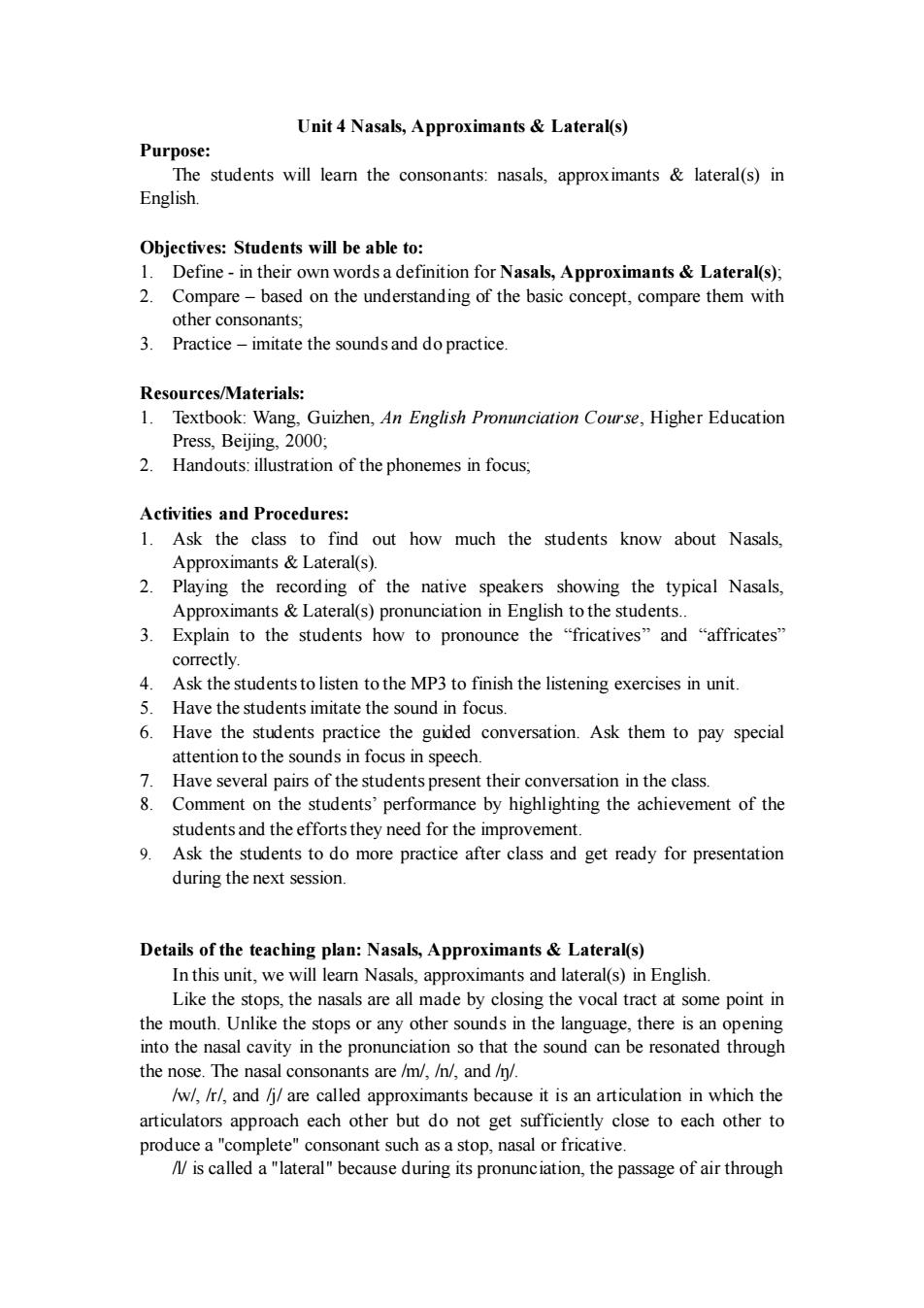正在加载图片...

Unit 4 Nasals,Approximants Lateral(s) Purpose e students will lear the consonants:nasals,approximants&lateral(s)in English. Obiectives:Students will be able to: Define-in their own wordsa definition for Nasals,Approximants&Lateral(s) 2. Compare -based on the understanding of the basic concept,compare them with other consonants, 3.Practice-imitate the soundsand do practice. Resources/materials Textbook:Wang. Guizhen,An English Pronunciation Course,Higher Education Press,Beijing.00 2.Handouts:illustration of the phonemes in focus; Activities and Procedures: 1.Ask the to find out how much the students know about Nasals. nts&Lateral(s). 2.Playing the recording of the native speakers showing the typical Nasals, Approximants Lateral(s)pronunciation in English to the students. 3.Explain to the students how to pronounce the "fricatives"and "affricates" 4 Ask the studentstolisten tothe MP3to finish the listening exercises in uni Have the students imitate the sound in focus 6. Have the students practice the guided conversation.Ask them to pay special attention to the sounds in focus in speech 7 Have several pairs of the students present their conversation in the class the students'perfor by highlighting the achievement of the students and the efforts they need for the improvement 9. Ask the students to do more practice after class and get ready for presentation during the next session. Details of the teaching plan:Nasals,Approximants Lateral(s In this unit,we will learn Nasals,approximants and lateral(s)in English. Like the stops,the nasals are all made by closing the vocal tract at some point in the mouth.Unlike the stops or any other sounds in the language.there is an opening the ose The nts are /m/,/n/,and / and j/are called approximants because it is an articulation in which the articulators approach each other but do not get sufficiently close to each other to produce a"complete"consonant such as a stop,nasal or fricative. n/is called a"lateral"because during its pronunciation,the passage of air through Unit 4 Nasals, Approximants & Lateral(s) Purpose: The students will learn the consonants: nasals, approximants & lateral(s) in English. Objectives: Students will be able to: 1. Define - in their own words a definition for Nasals, Approximants & Lateral(s); 2. Compare – based on the understanding of the basic concept, compare them with other consonants; 3. Practice – imitate the sounds and do practice. Resources/Materials: 1. Textbook: Wang, Guizhen, An English Pronunciation Course, Higher Education Press, Beijing, 2000; 2. Handouts: illustration of the phonemes in focus; Activities and Procedures: 1. Ask the class to find out how much the students know about Nasals, Approximants & Lateral(s). 2. Playing the recording of the native speakers showing the typical Nasals, Approximants & Lateral(s) pronunciation in English to the students. 3. Explain to the students how to pronounce the “fricatives” and “affricates” correctly. 4. Ask the students to listen to the MP3 to finish the listening exercises in unit. 5. Have the students imitate the sound in focus. 6. Have the students practice the guided conversation. Ask them to pay special attention to the sounds in focus in speech. 7. Have several pairs of the students present their conversation in the class. 8. Comment on the students’ performance by highlighting the achievement of the students and the efforts they need for the improvement. 9. Ask the students to do more practice after class and get ready for presentation during the next session. Details of the teaching plan: Nasals, Approximants & Lateral(s) In this unit, we will learn Nasals, approximants and lateral(s) in English. Like the stops, the nasals are all made by closing the vocal tract at some point in the mouth. Unlike the stops or any other sounds in the language, there is an opening into the nasal cavity in the pronunciation so that the sound can be resonated through the nose. The nasal consonants are /m/, /n/, and /ŋ/. /w/, /r/, and /j/ are called approximants because it is an articulation in which the articulators approach each other but do not get sufficiently close to each other to produce a "complete" consonant such as a stop, nasal or fricative. /l/ is called a "lateral" because during its pronunciation, the passage of air through